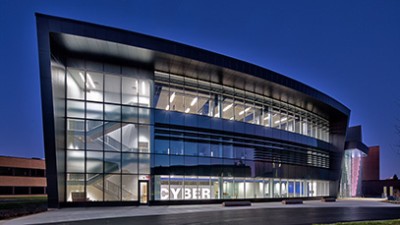Student spotlight: Fulbright Ukraine student research applies AI to real-world problems
Abdullah Awan
Diana Velychko is a Fulbright Ukraine student studying and researching artificial intelligence at RIT.
Diana Velychko, a Fulbright master’s student in artificial intelligence, is paving the way for more intuitive artificial intelligence (AI) systems.
Originally from Ternopil, Ukraine, Velychko’s academic journey has taken her to exchange programs across Europe and now to RIT. Her work focuses on the intersection of human perception and AI, aiming to bridge the gap between how people see the world and how machines interpret it. Through her classes and research, she works to apply AI to real-world problems.
What made you want to study AI?
While in Ukraine, I took an AI machine learning course where we did a project in computer vision. Even though ChatGPT wasn’t around yet, I thought AI might be good for the future. I found it to be really challenging and really exciting. I like that we can create something that we can’t really predict what it’s going to do.
How did you become a Fulbright student?
I’ve had a diverse educational experience owing to studying at Ternopil Ivan Pul’uj National Technical University which allowed me to do a few exchange programs in Europe, including a semester abroad in Spain and Lithuania. I was excited to see what university life is like in U.S., so I applied for the Fulbright Ukraine program. RIT was my first choice because it offered a specialized master’s in AI—something that is rare and not typically offered as a standalone degree. I’m really grateful for the helpful professors at RIT and for the Fulbright program that allowed me to gain new perspectives.
What projects are you working on in AI?
I just published a paper in satellite imagery. As a machine learning intern in the Adaptive Human-Robot Teaming Lab last summer, with Assistant Professor Jamison Heard, improved a model that detects cars, ships, planes, trains and other small moving objects in satellite imagery. We trained the model to be more robust toward perturbations, or noise in the training data.
In RIT’s Brain Lab, I’m collaborating with computer engineering researcher Associate Professor Cory Merkel and psychology researcher Professor Andrew Herbert to understand how humans learn to classify synthetic images they’ve never seen before. Using eye-tracking technology, we analyze which parts of an image people pay attention to when learning about new objects. The goal is to apply these patterns to enhance AI architecture, so AI models classify objects more robustly, similarly to humans.
What are some ways that AI can help people?
Right now, Ukraine has electricity shortages due to the ongoing war and bombarding that has destroyed electrical stations. So, officials schedule when electricity can be available to different populations. Just the other day, my family only had two hours of electricity for the day. However, it can take officials days—even weeks—to manually create these schedules and remake them after each attack.
In my Introduction to AI class with Professor Cecilia Alm at RIT, we learned about genetic algorithms—optimization techniques based on evolutionary principles. I was able to use those algorithms in a project to quickly create schedules, saving time and allowing people to plan when they will get access to electricity. I published a paper on this topic in Ukraine. Recently, an AI-based algorithm was introduced to accelerate the process of energy redistribution and the creation of electricity schedules.










